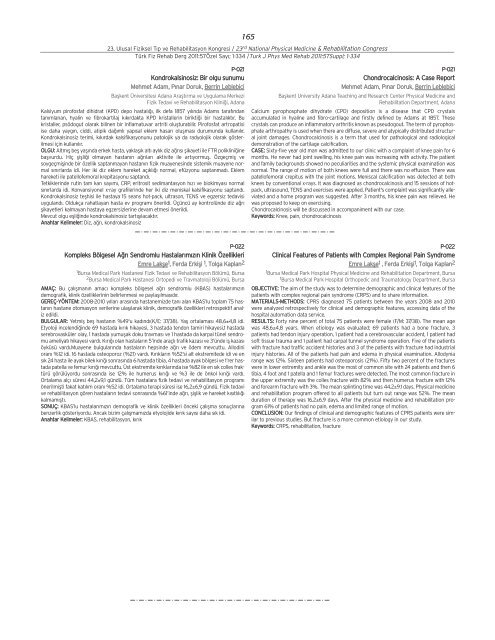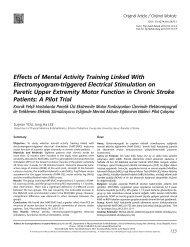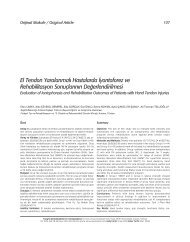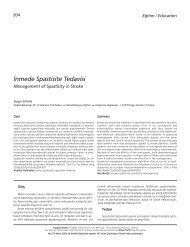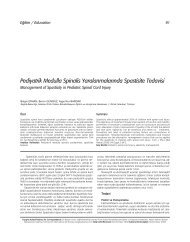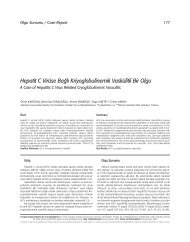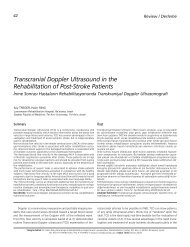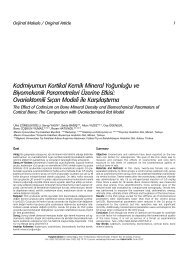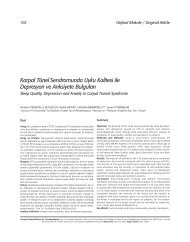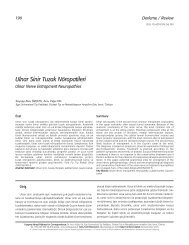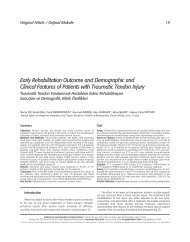‹nmeli Hastalarda Yaflflam Kalitesini Etkileyen ... - FTR Dergisi
‹nmeli Hastalarda Yaflflam Kalitesini Etkileyen ... - FTR Dergisi
‹nmeli Hastalarda Yaflflam Kalitesini Etkileyen ... - FTR Dergisi
Create successful ePaper yourself
Turn your PDF publications into a flip-book with our unique Google optimized e-Paper software.
165<br />
23. Ulusal Fiziksel T›p ve Rehabilitasyon Kongresi / 23 rd National Physical Medicine & Rehabilitation Congress<br />
Türk Fiz Rehab Derg 2011:57Özel Say›; 1-334 /Turk J Phys Med Rehab 2011:57Suppl; 1-334<br />
P-021<br />
Kondrokalsinosiz: Bir olgu sunumu<br />
Mehmet Adam, P›nar Doruk, Berrin Leblebici<br />
Baflkent Üniversitesi Adana Araflt›rma ve Uygulama Merkezi<br />
Fizik Tedavi ve Rehabilitasyon Klini¤i, Adana<br />
Kalsiyum pirofosfat dihidrat (KPD) depo hastal›¤›, ilk defa 1857 y›l›nda Adams taraf›ndan<br />
tan›mlanan, hyalin ve fibrokartilaj k›k›rdakta KPD kristallerin birikti¤i bir hastal›kt›r. Bu<br />
kristaller, psödogut olarak bilinen bir inflamatuvar artriti oluflturabilir. Pirofosfat artropatisi<br />
ise daha yayg›n, ciddi, atipik da¤›ml› yap›sal eklem hasar› oluflmas› durumunda kullan›l›r.<br />
Kondrokalsinosiz terimi, k›k›rdak kalsifikasyonunu patolojik ya da radyolojik olarak gösterilmesi<br />
için kullan›l›r.<br />
OLGU: Altm›fl befl yafl›nda erkek hasta, yaklafl›k alt› ayl›k diz a¤r›s› flikayeti ile <strong>FTR</strong> poliklini¤ine<br />
baflvurdu. Hiç fliflli¤i olmayan hastan›n a¤r›lar› aktivite ile art›yormufl. Özgeçmifl ve<br />
soygeçmiflinde bir özellik saptanmayan hastan›n fizik muayenesinde sistemik muayene normal<br />
s›n›rlarda idi. Her iki diz eklem hareket aç›kl›¤› normal, efüzyonu saptanmad›. Eklem<br />
hareketi ile patellofemoral krepitasyonu saptand›.<br />
Tetkiklerinde rutin tam kan say›m›, CRP, eritrosit sedimantasyon h›z› ve biokimyas› normal<br />
s›n›rlarda idi. Konvansiyonel x-ray grafilerinde her iki diz meniskal kalsifikasyonu saptand›.<br />
Kondrokalsinosiz teflhisi ile hastaya 15 seans hot-pack, ultrason, TENS ve egzersiz tedavisi<br />
uyguland›. Oldukça rahatlayan hasta ev program› önerildi. Üçüncü ay kontrolünde diz a¤r›<br />
flikayetleri kalmayan hastaya egzersizlerine devam etmesi önerildi.<br />
Mevcut olgu eflli¤inde kondrokalsinosiz tart›fl›lacakt›r.<br />
Anahtar Kelimeler: Diz, a¤r›, kondrokalsinosiz<br />
P-022<br />
Kompleks Bölgesel A¤r› Sendromlu Hastalar›m›z›n Klinik Özellikleri<br />
Emre Lakfle 1, Ferda Erkifli 1, Tolga Kaplan 2<br />
1 Bursa Medical Park Hastanesi Fizik Tedavi ve Rehabilitasyon Bölümü, Bursa<br />
2 Bursa Medical Park Hastanesi Ortopedi ve Travmatoloji Bölümü, Bursa<br />
AMAÇ: Bu çal›flman›n amac› kompleks bölgesel a¤r› sendromlu (KBAS) hastalar›m›z›n<br />
demografik, klinik özelliklerinin belirlenmesi ve paylafl›lmas›d›r.<br />
GEREÇ-YÖNTEM: 2008-2010 y›llar› aras›nda hastanemizde tan› alan KBAS’lu toplam 75 hastan›n<br />
hastane otomasyon verilerine ulafl›larak klinik, demografik özellikleri retrospektif analiz<br />
edildi.<br />
BULGULAR: Yetmifl befl hastan›n %49'u kad›nd›(K/E: 37/38). Yafl ortalamas› 48,6±4,8 idi.<br />
Etyoloji incelendi¤inde 69 hastada k›r›k hikayesi, 3 hastada tendon tamiri hikayesi,1 hastada<br />
serebrovasküler olay, 1 hastada yumuflak doku travmas› ve 1 hastada da karpal tünel sendromu<br />
ameliyat› hikayesi vard›. K›r›¤› olan hastalar›n 5’inde araçl› trafik kazas› ve 3’ünde ifl kazas›<br />
öyküsü vard›.Muayene bulgular›nda hastalar›n hepsinde a¤r› ve ödem mevcuttu. Allodini<br />
oran› %12 idi. 16 hastada osteoporoz (%21) vard›. K›r›klar›n %52’si alt ekstremitede idi ve en<br />
s›k 24 hasta ile ayak bilek k›r›¤› sonras›nda 6 hastada tibia, 4 hastada ayak bölgesi ve 1’rer hastada<br />
patella ve femur k›r›¤› mevcuttu. Üst ekstremite k›r›klar›nda ise %82 ile en s›k colles fraktürü<br />
görülüyordu sonras›nda ise 12% ile humerus k›r›¤› ve %3 ile de önkol k›r›¤› vard›.<br />
Ortalama alç› süresi 44,2±9,1 gündü. Tüm hastalara fizik tedavi ve rehabilitasyon program›<br />
önerilmiflti fakat kat›l›m oran› %52 idi. Ortalama terapi süresi ise 16,2±6,9 gündü. Fizik tedavi<br />
ve rehabilitasyon gören hastalar›n tedavi sonras›nda %61’inde a¤r›, flifllik ve hareket k›s›tl›l›¤›<br />
kalmam›flt›.<br />
SONUÇ: KBAS’lu hastalar›m›z›n demografik ve klinik özellikleri önceki çal›flma sonuçlar›na<br />
benzerlik gösteriyordu. Ancak bizim çal›flmam›zda etyolojide k›r›k say›s› daha s›k idi.<br />
Anahtar Kelimeler: KBAS, rehabilitasyon, k›r›k<br />
P-021<br />
Chondrocalcinosis: A Case Report<br />
Mehmet Adam, P›nar Doruk, Berrin Leblebici<br />
Baflkent University Adana Teaching and Research Center Physical Medicine and<br />
Rehabilitation Department, Adana<br />
Calcium pyrophosphate dihydrate (CPD) deposition is a disease that CPD crystals<br />
accumulated in hyaline and fibro-cartilage and firstly defined by Adams at 1857. These<br />
crystals can produce an inflammatory arthritis known as pseudogout. The term of pyrophosphate<br />
arthropathy is used when there are diffuse, severe and atypically distributed structural<br />
joint damages. Chondrocalcinosis is a term that used for pathological and radiological<br />
demonstration of the cartilage calcification.<br />
CASE: Sixty-five year old man was admitted to our clinic with a complaint of knee pain for 6<br />
months. He never had joint swelling, his knee pain was increasing with activity. The patient<br />
and family backgrounds showed no peculiarities and the systemic physical examination was<br />
normal. The range of motion of both knees were full and there was no effusion. There was<br />
patellofemoral crepitus with the joint motions. Meniscal calcification was detected at both<br />
knees by conventional x-rays. It was diagnosed as chondrocalcinosis and 15 sessions of hotpack,<br />
ultrasound, TENS and exercises were applied. Patient's complaint was significantly alleviated<br />
and a home program was suggested. After 3 months, his knee pain was relieved. He<br />
was proposed to keep on exercising.<br />
Chondrocalcinosis will be discussed in accompaniment with our case.<br />
Keywords: Knee, pain, chondrocalcinosis<br />
P-022<br />
Clinical Features of Patients with Complex Regional Pain Syndrome<br />
Emre Lakfle 1 , Ferda Erkifli 1, Tolga Kaplan 2<br />
1 Bursa Medical Park Hospital Physical Medicine and Rehabilitation Department, Bursa<br />
1 Bursa Medical Park Hospital Orthopedic and Traumatology Department, Bursa<br />
OBJECTIVE: The aim of the study was to determine demographic and clinical features of the<br />
patients with complex regional pain syndrome (CRPS) and to share information.<br />
MATERIALS-METHODS: CPRS diagnosed 75 patients between the years 2008 and 2010<br />
were analyzed retrospectively for clinical and demographic features, accessing data of the<br />
hospital automation data service.<br />
RESULTS: Forty nine percent of total 75 patients were female (F/M: 37/38). The mean age<br />
was 48,6±4,8 years. When etiology was evaluated; 69 patients had a bone fracture, 3<br />
patients had tendon injury operation, 1 patient had a cerebrovascular accident, 1 patient had<br />
soft tissue trauma and 1 patient had carpal tunnel syndrome operation. Five of the patients<br />
with fracture had traffic accident histories and 3 of the patients with fracture had industrial<br />
injury histories. All of the patients had pain and edema in physical examination. Allodynia<br />
range was 12%. Sixteen patients had osteoporosis (21%). Fifty two percent of the fractures<br />
were in lower extremity and ankle was the most of common site with 24 patients and then 6<br />
tibia, 4 foot and 1 patella and 1 femur fractures were detected. The most common fracture in<br />
the upper extremity was the colles fracture with 82% and then humerus fracture with 12%<br />
and forearm fracture with 3%. The mean splinting time was 44.2±9.1 days. Physical medicine<br />
and rehabilitation program offered to all patients but turn out range was 52%. The mean<br />
duration of therapy was 16.2±6.9 days. After the physical medicine and rehabilitation program<br />
61% of patients had no pain, edema and limited range of motion.<br />
CONCLUSION: Our findings of clinical and demographic features of CPRS patients were similar<br />
to previous studies. But fracture is a more common etiology in our study.<br />
Keywords: CRPS, rehabilitation, fracture


